Strategies to Get Your Closing Costs Waived: A Comprehensive Guide
Introduction:
Verify my mortgage eligibility (May 9th, 2025)Closing costs, which often range from 2% to 5% of the home purchase price, can be a significant burden for many homebuyers. They encompass a variety of fees, including loan origination fees, appraisal fees, and title insurance. Although they’re a standard part of the home buying process, there are strategies you can employ to potentially have these costs waived or reduced.
Section 1: Understand Your Closing Costs
The first step is understanding what your closing costs entail. Review the Loan Estimate and Closing Disclosure forms provided by your lender to identify where your money is going and pinpoint areas for potential reductions.
Verify my mortgage eligibility (May 9th, 2025)Section 2: Negotiating Closing Costs with Your Lender
Some closing costs are negotiable. Speak with your lender about waiving or reducing certain fees, like loan origination fees or discount points. Keep in mind that lenders are in the business of creating loans, and you may have more negotiating power than you think, especially if you have strong credit or are making a large down payment.
Section 3: Seller Concessions
Verify my mortgage eligibility (May 9th, 2025)In some markets, especially those favoring buyers, you might be able to negotiate for the seller to pay a portion or all of your closing costs. This is known as a seller concession. The limit for concessions varies depending on the type of mortgage, so check with your lender about the possibility and limits of this strategy.
Section 4: Lender Credits
Lender credits are a way for your lender to cover some of your closing costs in exchange for a higher interest rate on your mortgage. While this strategy reduces your upfront costs, it increases the total interest you’ll pay over the life of the loan, so careful calculation is needed to see if this trade-off makes sense for your situation.
Verify my mortgage eligibility (May 9th, 2025)Section 5: No-Closing-Cost Mortgages
In a no-closing-cost mortgage, your lender rolls your closing costs into the total loan amount or charges a higher interest rate to cover them. Again, while this eliminates the need for upfront cash, it can cost more in the long term. Be sure to evaluate this option carefully.
Section 6: Housing Assistance Programs
Verify my mortgage eligibility (May 9th, 2025)Look into housing assistance programs, both at the national and local levels. Some offer grants or loans to cover closing costs for eligible buyers, often first-timers or those with low-to-moderate incomes.
Conclusion:
Getting your closing costs waived or reduced requires a combination of negotiation skills, market conditions, and financial acumen. By understanding your closing costs and exploring different options, you can potentially save thousands of dollars on your home purchase. Always be sure to do the math and consider the long-term implications before making any decision.
Show me today's rates (May 9th, 2025)
